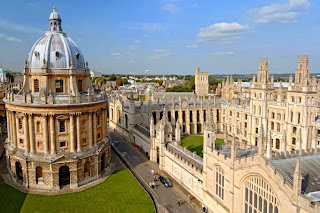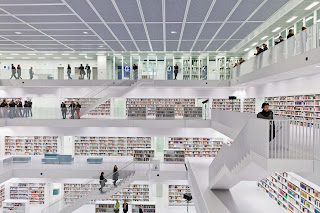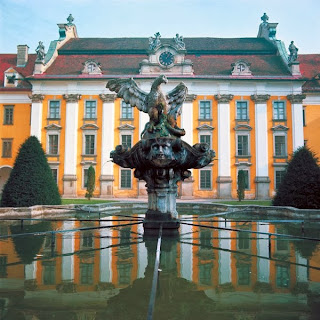I might be the most self-proclaimed nerd I know...While most people watch reality shows, football, and read novels to relax in the evening aftermath once kids are tucked into bed, I collect information and photos about libraries! I was so awestruck by this article from, Architectural Digest, "The Most Spectacular Libaries Around the World," by Tim McKeough, I just had to share. If this article does not inspire you to travel around the world and/or convert to librarian-ism (if there is such a thing), I am not sure what will! As a side note, I have traveled to 7 of these 15 cities, which is motivating me to put the remaining on my bucket list!
These libraries are breathtaking from an architectural/design as well as tourist perspective. They seem to reflect the flavor of each respective city in terms of architectural trends (traditional versus modern)...Without further ramblings, please enjoy...
"THE MOST SPECTACULAR
LIBRARIES AROUND THE WORLD"
Text by Tim McKeough
These public spaces
dedicated to printed and digital media prove that even the quietest of
buildings can make a loud-and-clear design statement.
As physical containers
for a society’s shared knowledge, historical documents, and academic musings,
libraries have always shouldered an enormous responsibility. But beyond merely
serving as archives, the best libraries also inspire. Housed in architecturally
ambitious structures, they are places that celebrate human achievement with
awesome environments. Indeed, there are obvious parallels between an author and
an architect—both strive for greatness, with the objective of producing works
that will stand the test of time.
In today’s digital age, some may question whether
libraries are still relevant. As the more recently constructed examples in the
following slide show demonstrate, the answer among scholars and architects is
an emphatic yes. Libraries are evolving from establishments with a
primary focus on printed matter to dynamic public spaces that prize all forms
of media and foster community engagement. And they remain among the world’s
most cherished cultural institutions.
SEATTLE PUBLIC LIBRARY’S CENTRAL LIBRARY
Seattle
When it opened in 2004, the Seattle Public Library’s Central Library
changed everything. The 21st-century library shouldn’t only celebrate the book,
argued Dutch architect Rem Koolhaas of OMA,
but “redefine [it] as an information store where all potent forms of media, new
and old, are presented equally and legibly.” That thinking led to a reshuffling
of the library’s functional components, generating a striking
363,000-square-foot structure with a glassy faceted shell.
SEATTLE PUBLIC LIBRARY’S CENTRAL LIBRARY
Seattle
The reading room feels as progressive as the office of a Silicon Valley
start-up. In fact, the building has numerous high-tech features, including a
computerized book-handling system, where volumes with RFID tags are
automatically identified, sorted, and routed to readers. Other public levels,
including the so-called mixing chamber, the living room, and the kids’ space,
all bring library users together regardless of the intention of their visit or
course of study.
TRINITY COLLEGE OLD LIBRARY
Dublin
Featuring the largest book collection in Ireland, Trinity College's
library has been continually growing since the college was established in 1592.
In the early 18th century, the library gained a distinguished new home by Irish
architect Thomas Burgh. Now dubbed the Old Library, the structure remains one
of the country’s top tourist destinations.
TRINITY COLLEGE OLD LIBRARY
Dublin
It’s difficult to know which is the bigger draw—the stately interior of
the historic building or the notable works in its collection. Yes, the Long
Room, which features dark wood pilasters and a dramatic vaulted ceiling, is a
showstopper. But the lavishly illustrated Book of Kells, which dates from the
9th century, is here, too, and is bound to command at least some of every
visitor’s attention.
UNIVERSITY OF ABERDEEN NEW LIBRARY
Aberdeen, Scotland
The University of Aberdeen, founded in 1495, is one of the world’s
oldest English-language schools. However, its New Library, completed last year
by Denmark’s Schmidt Hammer Lassen Architects
makes it clear that the university is anything but stuck in the past. With
bold, irregular vertical stripes formed by insulated panels and
high-performance glass, the building serves as a beacon for students while
maximizing natural light and energy savings.
UNIVERSITY OF ABERDEEN NEW LIBRARY
Aberdeen, Scotland
The outside of the 167,000-square-foot building may be a strict box, but
the interior is full of fluid curves. The eight floors wrap energetically
around a central atrium, establishing an airy, light-filled environment. The
layout creates a visual connection among the students—but when it’s time to
focus, the building also offers 1,200 individual study spaces.
MUSASHINO ART UNIVERSITY MUSEUM & LIBRARY
Tokyo
In addition to chairs and tables, there’s one piece of furniture you’re
guaranteed to see in nearly every library—a bookshelf. But for the library at
Musashino Art University, Japanese architect Sou Fujimoto
took that idea to the extreme, building full-height walls "comprising
enormous bookcases. Enclosed within the building's glass façade, the otherwise
ordinary storage units create a compelling architectural statement when used in
multiples.
MUSASHINO ART UNIVERSITY MUSEUM & LIBRARY
Tokyo
Although there’s plenty of room for storage, most of the bookshelves
remain empty. A surprising twist for a library, it represents Fujimoto’s
knowing nod to the growing importance of digital information. In this library,
the stacks are populated with people.
CLEMENTINUM
Prague
Home of the National Library of the Czech Republic, the Clementinum is
housed in a series of historic buildings, the oldest dating from the 11th
century. Today the most frequently visited structures are the ones that were
built in the 18th century, including the 223-foot-tall astronomical tower,
which was used as an observatory until the 1930s.
CLEMENTINUM
Prague
With elaborate ceiling frescoes and spiraling
wood columns topped by gilded capitals, there is no mistaking the aptly named
Baroque Library’s grand ambitions. Containing a selection of unusual oversized
globes, it offers a reminder of its former patrons’ quest for worldly
knowledge.
THE ROYAL LIBRARY
Copenhagen
Designed by Schmidt Hammer Lassen Architects,
this extension doubled the size of Copenhagen’s original Royal Library when it
was completed in 1999. Clad in polished black granite, the structure is
nicknamed the Black Diamond. But it isn’t just a dark box—the building’s
monolithic form is bisected by an atrium of clear glass, which offers a
dramatic sense of transparency.
THE ROYAL LIBRARY
Copenhagen
The central atrium opens the library up to
the city and water, softening the edifice’s powerful stature. A majority of the
public functions are located here at the core of the building, which is
intended to serve as a public gathering space, while deeper interior spaces
offer more insulated rooms for study.
SAINTE-GENEVIÈVE LIBRARY
Paris
The Sainte-Geneviève Library, adjacent to the
Pantheon on Paris’s famed Left Bank, was designed by architect Henri Labrouste
in the mid-19th century. However, it holds materials much older than that—the
library inherited the collections of the ancient Abbey of Sainte-Geneviève,
which was founded in the 6th century.
SAINTE-GENEVIÈVE LIBRARY
Paris
Architecturally, the library is best known
for its exposed iron structure. The barrel vaults of the reading room are
supported by lacy iron arches, which are held aloft by a central row of slender
iron columns. Surrounded by windows, the room feels bright and inviting rather
than heavy or oppressive.
STEPHEN A. SCHWARZMAN BUILDING
New York City
The main branch of the New York Public
Library, the formidable Stephen A. Schwarzman Building is one of the city’s few
famous landmarks that doesn’t reach skyward. Designed by the legendary
architecture firm Carrère & Hastings and opened in 1911, the edifice
remained largely unchanged for more than a century. Now plans are under way for
a thoughtful renovation by Foster +
Partners to open up more interior space to the public.
STEPHEN A. SCHWARZMAN BUILDING
New York City
The heart of the library is the Rose Main
Reading Room, a cavernous volume that stretches nearly two city blocks long
beneath 52-foot-high ceilings. Abundant natural light streams in through
windows and ceiling murals depict the sky, making the space feel almost as
inviting as sitting outside. Despite the room’s formal feel, it’s equally
popular with studious readers and casual visitors in search of Wi-Fi.
BODLEIAN LIBRARY
Oxford, England
Originally opened in 1602, the University of
Oxford’s Bodleian Library certainly isn’t short on history. And after four
centuries’ worth of expansions, the principal library and its satellite
buildings now hold some 11 million printed items. One of those buildings, the
Radcliffe Camera, is a neoclassical circular structure designed by James Gibbs
in 1749 that has become an icon of Oxford’s campus.
BODLEIAN LIBRARY
Oxford, England
Considering the school’s long list of
world-changing alumni—including 26 British prime ministers, 50 Nobel Prize
winners, and such creative minds as Oscar Wilde and William Morris—it would be
difficult not to feel inspired studying in these halls. Meticulously paneled
rooms add to the weighty sense of history while offering a sense of envelopment
that counters outside distractions.
STUTTGART CITY LIBRARY
Stuttgart, Germany
Envisioned as a contemporary rectilinear
Pantheon for the modern age, the Stuttgart City Library, designed by the
Cologne-based firm Yi Architects,
is a cube-shaped building that pulls in sunlight through its translucent roof.
The concrete façade is punctuated by a grid of glass blocks that offers a play
of colorful lights at night—resulting in inevitable comparisons to a Rubik’s
Cube.
STUTTGART CITY LIBRARY
Stuttgart, Germany
The main circulation space and book stacks
are located on the building’s top five floors, where a spiraling series of staircases
gives the whole arrangement a funnel-like shape. Finishes are kept deliberately
simple—bright white surfaces help mix and maximize both natural and artificial
light to create study spaces that are decidedly crisp and fresh.
ST. FLORIAN MONASTERY
Sankt Florian, Austria
A succession of monasteries has stood on the
grounds since 819, but the current building, a masterwork of Baroque
architecture, was completed in the 18th century. Its basilica and art gallery
are both celebrated destinations on their own, but it’s the monastery’s library
that is perhaps the most transporting environment of all.
ST. FLORIAN MONASTERY
Sankt Florian, Austria
The library’s interior is a masterwork of
Baroque architecture with elaborate carved-wood bookcases and balustrades with
gilded details. A ceiling fresco by Bartolomeo Altomonte, completed in 1747,
presents allegorical subjects who watch over the great room from the clouds.
BIBLIOTHECA ALEXANDRINA
Alexandria, Egypt
The original Library of Alexandria,
established in the third century B.C., was one of the ancient world’s most
important centers of knowledge until it was destroyed in the third century A.D.
The new Bibliotheca Alexandrina, completed in 2002, was built in hopes of
creating a similar destination for scholarship.
BIBLIOTHECA ALEXANDRINA
Alexandria, Egypt
The project marked the arrival of Snøhetta, a previously unknown
architecture firm that beat out more than 1,400 competitors for the design
commission (and went on to design many other high-profile buildings, among them
the National September 11 Museum pavillion in New York). The enormous lopsided
building, which tilts toward the Mediterranean Sea, holds a range of
specialized libraries, four museums, a planetarium, a virtual-reality
environment, academic research centers, art galleries, and a conference center.
GEORGE PEABODY LIBRARY
Baltimore
Designed by Baltimore architect Edmund G.
Lind and completed in 1878, the George Peabody Library is widely regarded as
one of the most beautiful libraries in North America. When not supporting
research activities as part of Johns Hopkins University, it also doubles as one
of the city’s most popular event spaces.
GEORGE PEABODY LIBRARY
Baltimore
The library’s interior is what most visitors
find captivating—five book-filled floors with cast-iron balconies encircling a
central atrium where, if you’re lucky, you can pull up a chair at one of the
reading desks. The skylight 61 feet above allows sunlight to spill onto the
black-and-white black-and-white marble floor.
JOSÉ VASCONCELOS LIBRARY
Mexico City
An immense fortress of a building surrounded
by gardens, the 125,000-square-foot José Vasconcelos Library, designed by
architect Alberto Kalach, is a major
effort to promote increased Mexican literacy. However, ambitious architecture
sometimes suffers unforeseen problems—in this case, the library closed for
nearly two years after an initial opening in 2006, during which time workers
remedied construction defects.
JOSÉ VASCONCELOS LIBRARY
Mexico City
The library’s interior has a futuristic
appeal, featuring a soaring grand central hall inhabited by a matrix of
glass-and-steel boxes. Appearing to hover in midair, the elevated bookshelves
provide plenty of room for future growth—only one-third full at present, they
offer space for 1.5 million books.
VENNESLA LIBRARY AND CULTURAL CENTER
Vennesla, Norway
Designed by the Norwegian architecture firm Helen & Hard, the Vennesla Library and
Cultural Center reveals itself at a glance—even before you step inside. All
public rooms, including the library, café, and meeting places, share space
under a single curvaceous roof, while a continuous ground plane seamlessly
connects the building with the street outside.
VENNESLA LIBRARY AND CULTURAL CENTER
Vennesla, Norway
The main structure of the library area is
formed by 27 laminated wood ribs, which support the ceiling and then curl down
to the floor to provide functional elements such as bookshelves and seating.
The ribs also conceal required building components, such as air-conditioning
ducts and lighting, creating a clean, streamlined envelope that supports quiet
contemplation.































Your blog site is so superb. How fortunate to see everything you have created. Hope you proceed to do the job tough. I wish you possess a good health and wellbeing.
ReplyDeleteThis is so amazing. Great Tips !! Keep publishing the great content for your blog. Keep writing and sharing your thoughts with us. architecture firms in erode
ReplyDelete